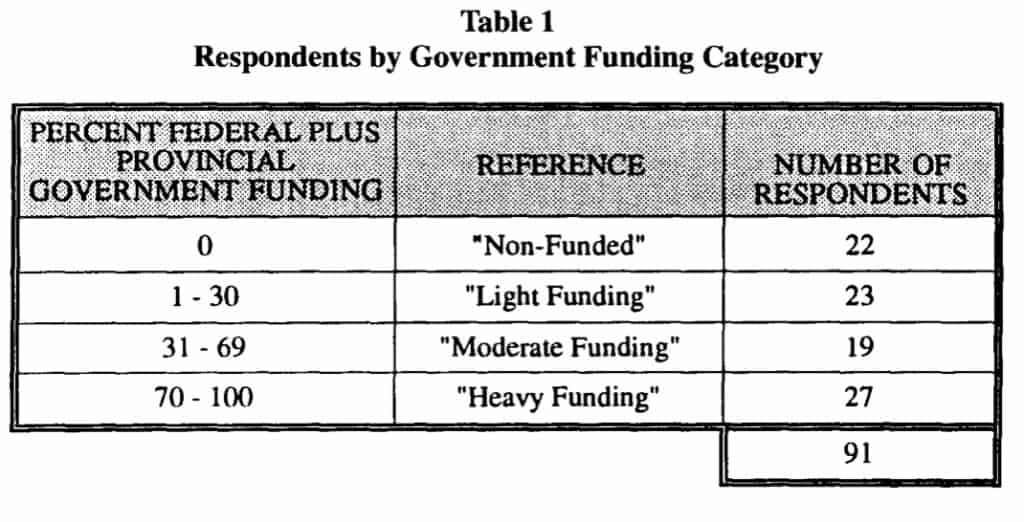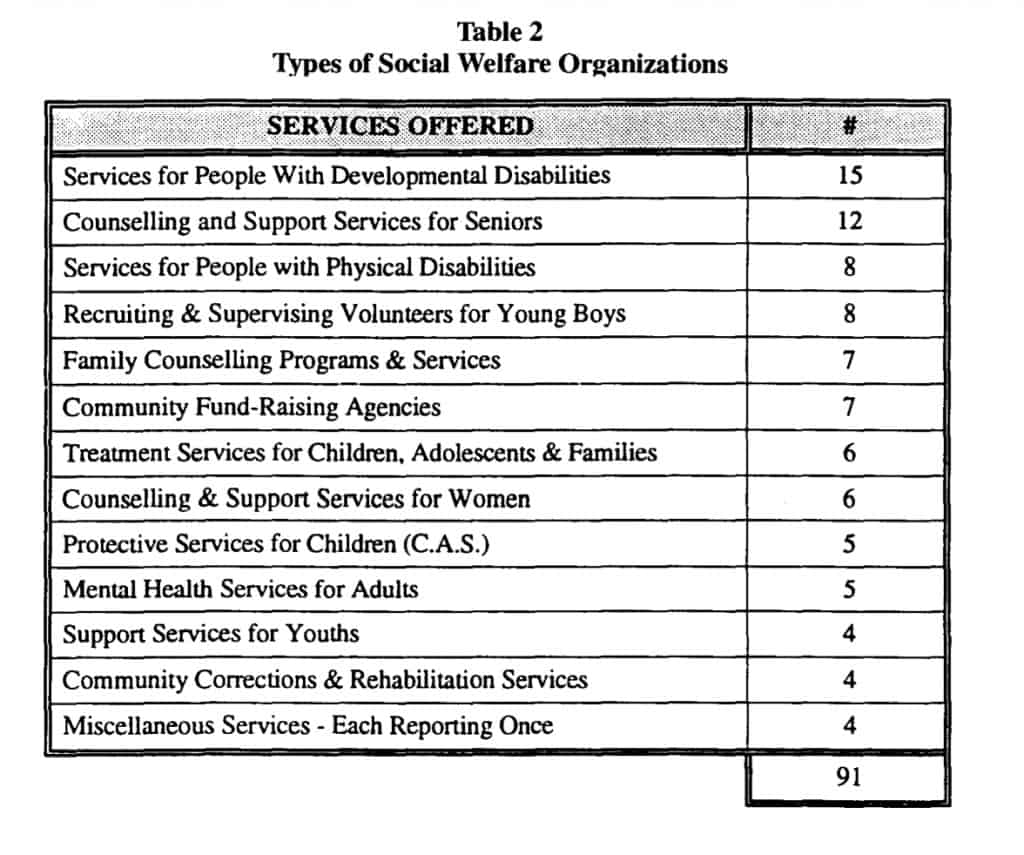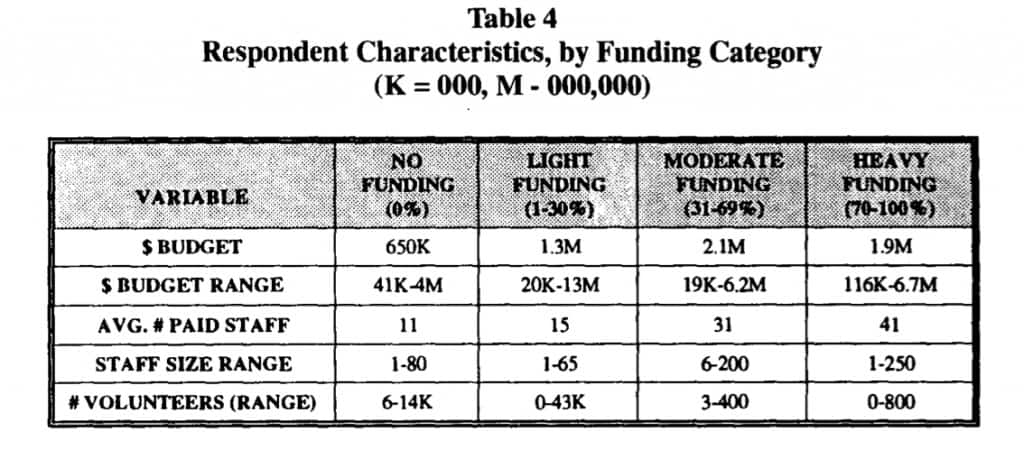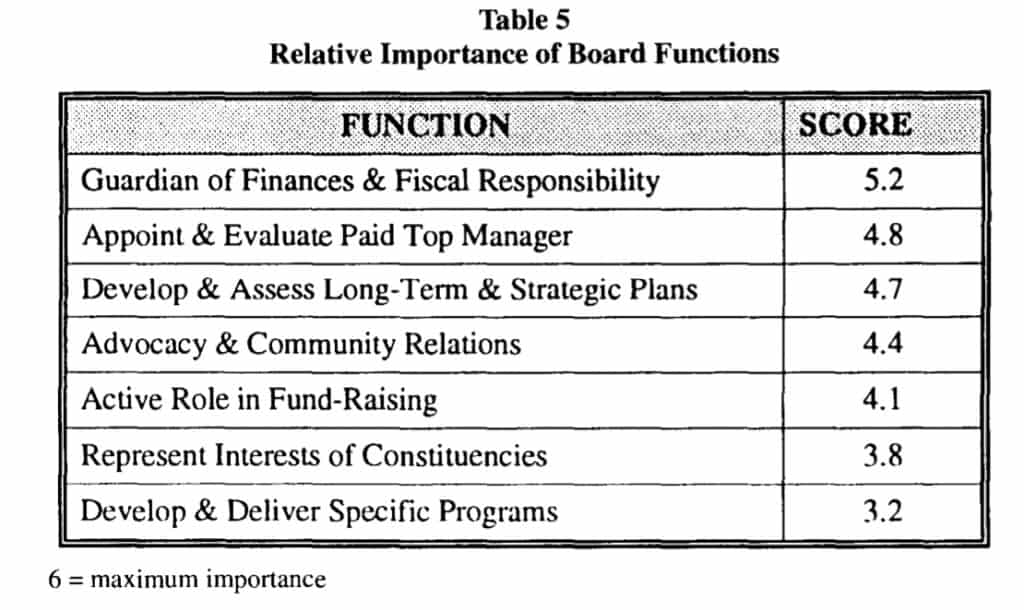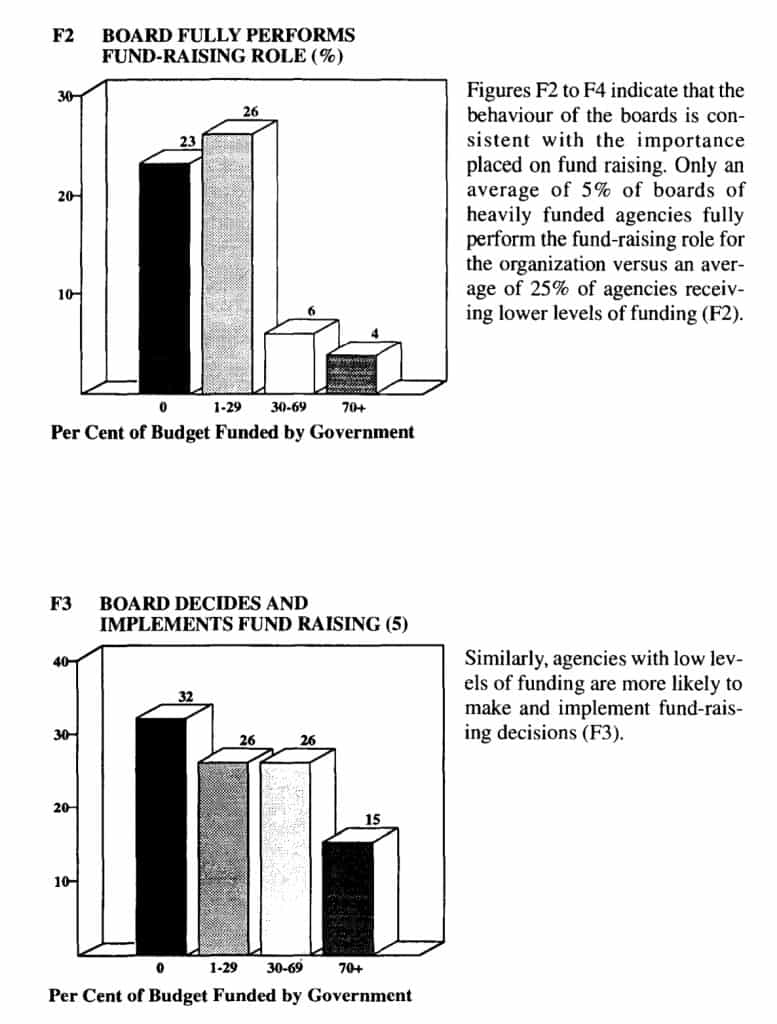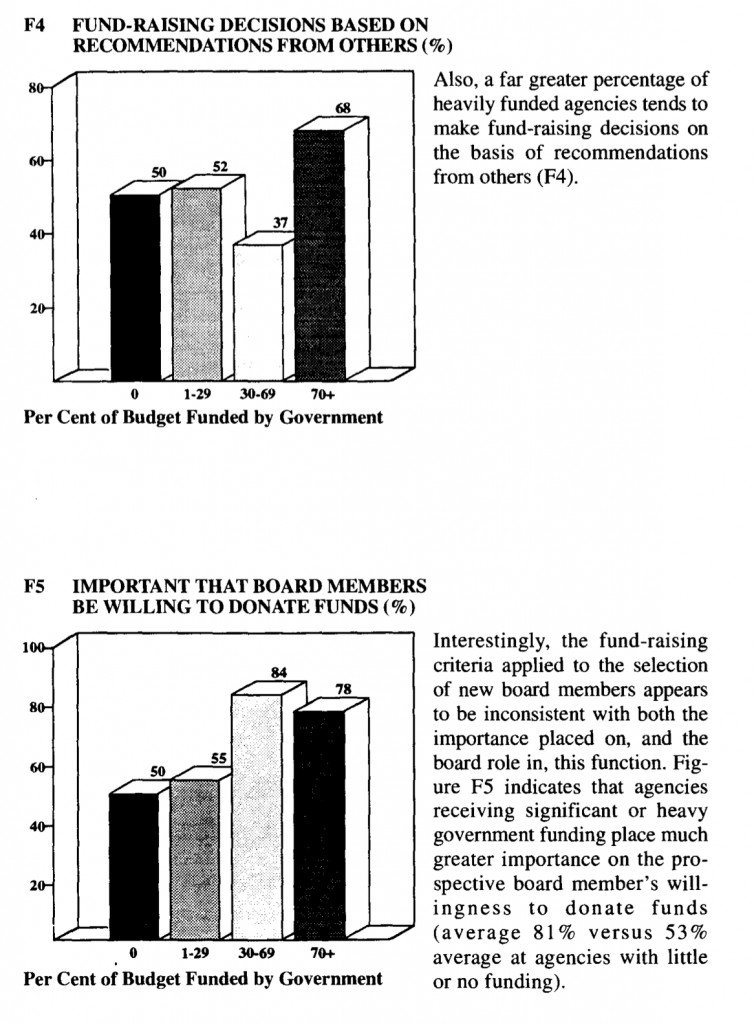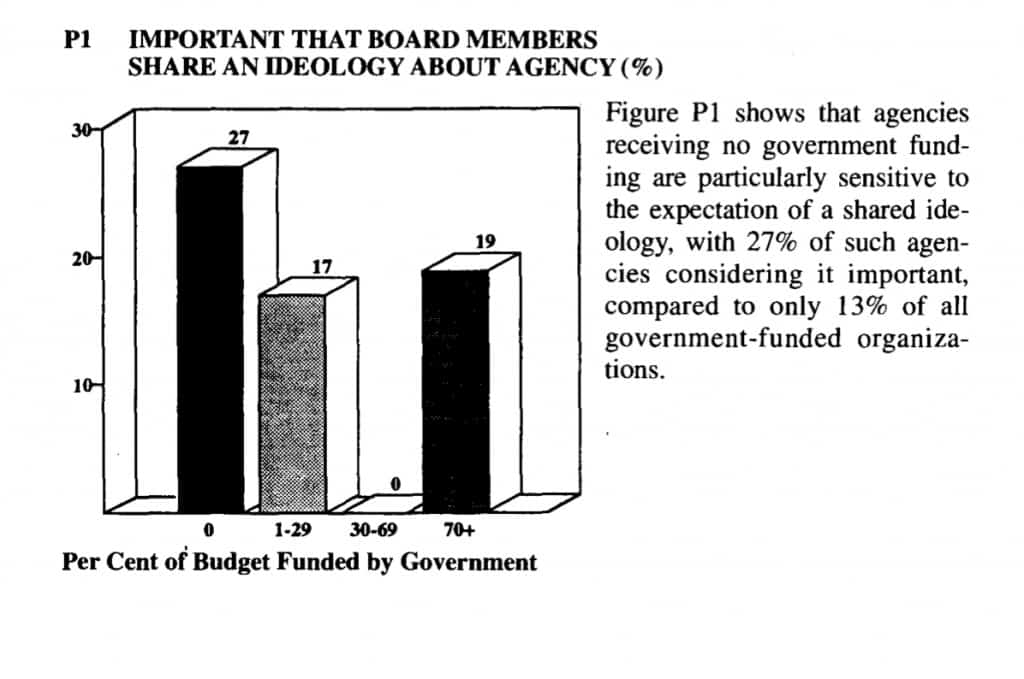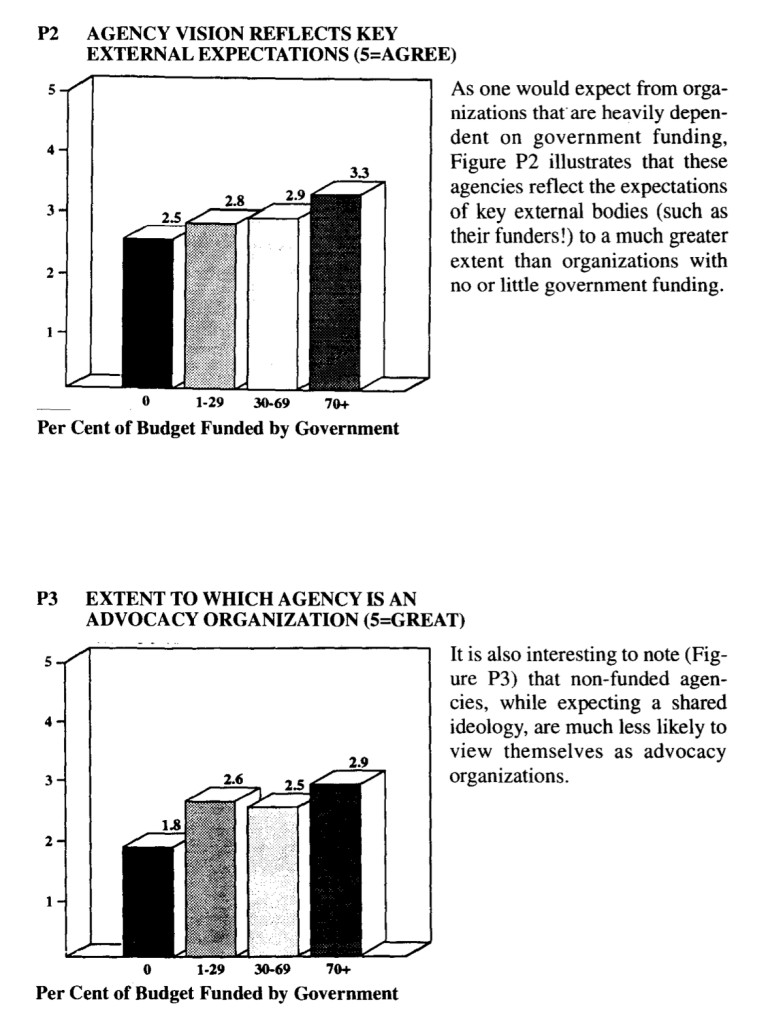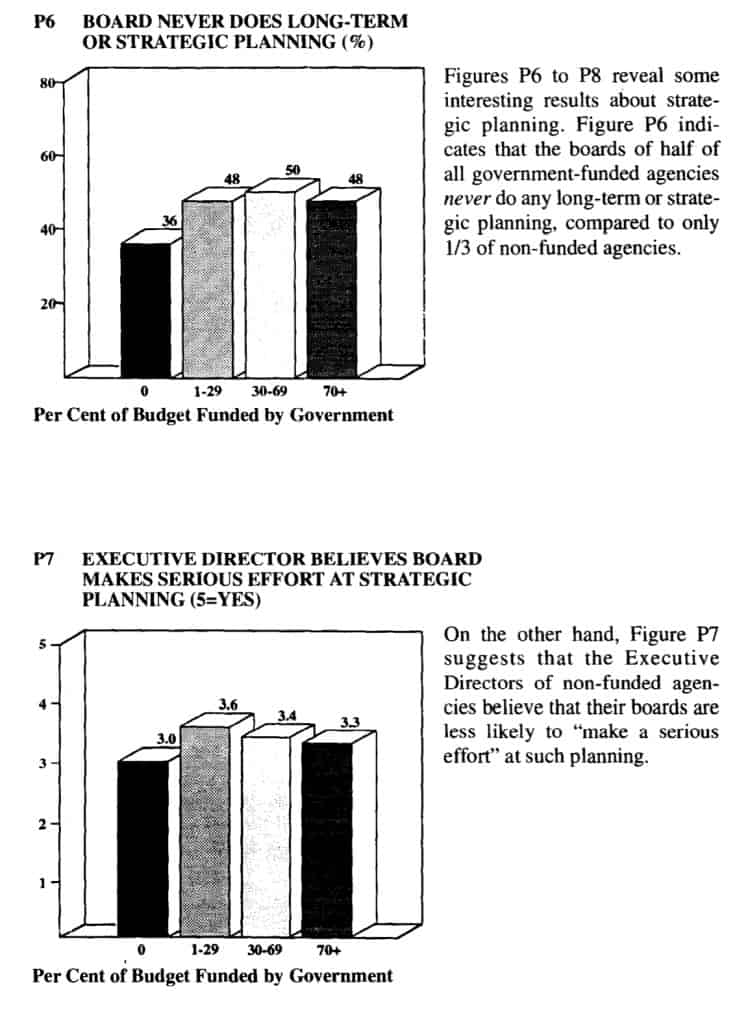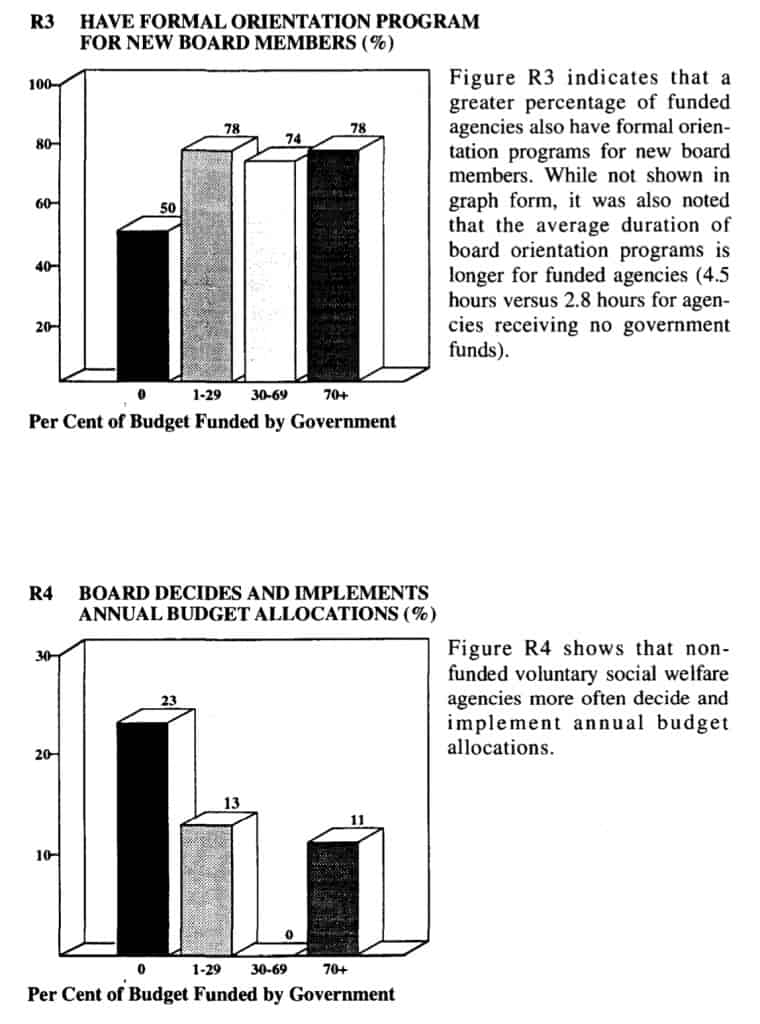Presented to the Sixth Conference on Social Welfare Policy, St. John’s, Newfoundland, June 27-30, 1993.
Introduction
Purpose
The purpose of this paper is to examine, within the framework of privatization by government, some of the traditional functions expected to be undertaken by boards of directors of voluntary social welfare organizations. This study focuses on the fund-raising function, the development and assessment of long-term and strategic plans, and the more general area of board-management relations. This last area includes budgeting, program development and delivery and management of senior staff.
As will be described more fully in the Methodology section, the authors identified a subset of 91 social welfare organizations from a larger study of not-for-profit (NFP) agencies, then divided the subset into four categories-depending on the per cent of their total operating budget funded by federal plus provincial governments. The hypothesis for this study is that the boards of heavily funded (privatized) agencies will behave differently in matters of governance than will the boards of agencies that receive no government funding. The emphasis throughout is on the differences between these two categories. Where possible, comments will be made on the patterns exhibited by the agencies found between those two funding extremes, i.e., those that are “lightly” or “moderately” funded by government
It should be noted that the study upon which this paper is based was conducted in late 1990 and early 1991. Recent developments in funding of many voluntary social welfare organizations, particularly relating to what many are referring to as “a crisis in government funding”, suggest that some of the study results might have been quite different were the study to be repeated in 1993. In fact, those differences have been observed by the authors in some recent cases, and are consistent with many of the concerns and conclusions of this paper.
Methodology
The data for this paper were drawn from the results of a 1990/91 survey of the 1,200 voluntary, NFP organizations on the mailing list of The Canadian Centre for Philanthropy. The survey, in the form of a 36-page questionnaire sent to the executive directors of each organization, was conducted by Victor Murray and Pat Bradshaw at York University. A 35 per cent response was achieved, for an overall sample of 417 usable returns. The responses provide a representative sampling of the variety of NPOs in Canada, with numerous responses from each key sector: health, social welfare, education, cultural organizations, religious groups, etc. Appendix A presents a list of respondents by sector.
This paper investigates the responses from organizations in the social welfare sector, which were defined as agencies whose purpose is to assist the disadvantaged or people with particular social problems. Of the 123 returns from this sector, 17 were removed from the subset because they were also active in one or more of the other sectors detailed in Appendix A A further 11 responses were culled from this paper’s data base since there was uncertainty as to whether the person who completed the questionnaire was actually an executive director or equivalent.
Of the remaining 95 respondents, four indicated that a significant portion of their total funds came from “fees-for-service paid by government”. Since this paper investigates differences between agencies that are and are not funded by government, and since these four respondents could not be placed in either category with assurance, they were also removed from the sample.
Table 1
Thus, the sample for this paper becomes 91 voluntary social welfare agencies whose executive director or equivalent completed the questionnaire. Those 91 respondents were grouped into four categories, based on the combined percentage of their total funds received from the federal plus their provincial governments. (Table 1)
Finally, it should be noted that the data for this paper were drawn from the results of an investigation of a much larger sampling of NFP organizations, with a much broader focus. While the initial study, called a Survey of the Effectiveness of Not-For-Profit Organization Boards, provides an extensive database from which to draw, it did not specifically focus on the issue of privatization. Thus, while the observations are valid, the data can only tentatively be considered to support the conclusions.
Profile
Table 2 outlines the types of social welfare organizations included in the sample. Twelve distinct groups of agencies emerged:
A provincial breakdown of respondents in Table 3 indicates some skewing of the results towards Ontario and away from Quebec, with the Western provinces adequately represented. While the authors conclude that this bias is probably the result of a skewing in the membership list of The Canadian Centre for Philanthropy, the reader should note that many respondents are national organizations with a head office in Ontario-usually either Ottawa or Toronto–but with operations in many or all Canadian provinces:
Table 3
Table 4 details some key operating variables for the responding agencies, such as budget and staff size. These results are delineated for each of the four funding categories introduced earlier:
Table 4
Overview
Privatization
Stoez (1981) perceives privatization as the systematic turning over of social services to the private sector. The need to restrain government welfare costs and the emergence of a neo-conservative ideology in some governments (Azim, 1987) are perceived to be primary factors in the growth of privatization. Numerous authors have identified the three methods of privatization currently employed by a variety of governments. They include:
1. Government refusing to accept any further responsibility for either the provision or delivering of social services. In this extreme situation, the government would not only withdraw from the delivery of needed social services, but would cease to provide funds to the voluntary sector to deliver such services.
2. Government which over a period of time had become involved with the funding and provision of many services decides to limit its responsibility to the provision and delivery of services mandated by the federal or provincial statutes. The delivery and funding for all other services would be turned over to the voluntary sector.
3. Government would maintain responsibility for funding traditional public social services, but transfer the delivery of such services to the voluntary sector.
A number of critics, including Azim and Ramesh Mishra (1988) have expressed concern regarding the long-term effects of privatization on the delivery of social services. On the other hand, a position, supported by the Canadian Association of Social Workers’ (CASW) submission to the Royal Commission on Economic Union and Development Prospects in Canada (1983) suggests that the voluntary sector is capable of doing a better job of delivering such services. Mishra perceives the CASW position as unwittingly providing a convenient rationale for government to withdraw from service delivery.
Up to this point, the third form of privatization has been practised in many provinces, particularly in relation to services eligible for funding through the Canada Assistance Plan. A number of the authors included in Privatization and Provincial Social Services in Canada (1988) confirm the increasing trend towards privatization. This trend has been particularly clear in child welfare services in provinces such as Manitoba, British Columbia and Ontario, where public funds have replaced a .dependency on voluntary donations through organizations such as the United Way. To a lesser extent, the privatization of services for the aged and the physically handicapped is also under way.
In a parallel development, the national strategy for the deinstitutionalization of people with developmental handicaps has brought about the development and expansion of many community-based voluntary organizations specifically designed to provide services to this group. With the exception of limited revenue generated by workshops and donations, these organizations have been funded primarily by governments. While one might applaud the government’s recognition that deinstitutionalization often enhances quality of life, and can be beneficial for human dignity, it is also worth noting that the process-either by accident or by design-greatly facilitates the governments’ privatization efforts. Further, it extends the concept of privatization to include the reduction of funding by often replacing unionized civil servants with lower-paid nonunionized staff, and by making it easier to limit the budgets of small, dependent organizations.
The Voluntary Organization and Governance
In her 1988 paper entitled, “Privatization: Increasing Government Efficiency or Dismantling the Welfare State?” Erica Bell-Lowther makes an important statement concerning the autonomy of the voluntary agency and privatization. She notes:
The literature on the political economy of privatization and voluntary organizations documents that voluntary agencies in the U.S. have been forced to become more opportunistic, entrepreneurial and political to survive. Major changes have taken place in their organizational environment. There is an increasing reliance on government funds tied to specific services rather than to general operating grants. Agency resources are reallocated to securing government contracts and tailoring services to tenders requested by governments. This results in the loss of many of the advantages of voluntary organizations: their flexibility, innovativeness, ability to promote citizen participation and their advocacy and social reform roles.
The voluntary agency is described in this paper as an NFP organization directed by a board of directors composed of paid staff and/or community volunteers. This type of organization has had a long and distinguished history of developing and delivering social services in North America. Kramer, in Voluntary Agencies in the Welfare State (1981), suggests that the voluntary organization has four major roles in modern society:
1. The voluntary agency is in the vanguard. It tends to be the pioneerthe institution that will experiment with innovative programs to meet current or emergency needs. Demonstration projects will frequently be developed and, if successful, may be taken over by the government.
2. The voluntary agency is perceived as the critic or gadfly that performs a “watchdog function” over government-operated services. It functions as the empowerer or advocate that pressures the government to extend, improve or establish needed services.
3. The voluntary agency is seen as “value guardian of voluntaristic, particularistic and secondary values”. It is expected to promote citizen participation, develop leadership and protect special interest groups.
4. The voluntary agency is the service provider which delivers certain services it has selected. It may decide to offer social services that the government is unable, or unwilling, to provide.
Wilensky and Lebeaux (1958) state that governance of the voluntary agency, with some few exceptions related to religious groups, has evolved from the nineteenth century when a group of wealthy individuals would declare themselves to be the “patrons” of a particular charity, and would therefore serve as the agency’s board of directors. Since the main focus of these early agencies was limited to providing financial relief for the poor, the major function of the board was to supply monies from themselves and their friends. The emphasis on boards providing operational funds for the agency has decreased with the growth of federated or community fund raising. However, fund raising and the associated “overview” perspective with respect to accountability for community-raised funds remain important functions for the voluntary board of directors.
Slavin, in his 1985 Introduction to a series of articles related to voluntary boards of directors, suggests that such boards are responsible for the following functions:
1. Establishing the legal entity and legitimacy of the agency;
2. Establishing and maintaining financial integrity, solvency and accountability;
3. Engaging and evaluating the chief executive officer;
4. Managing financial investments;
5. Establishing personnel policies;
6. Serving as advocates for the organization and its services;
7. Serving as a link between the relevant community and the agency; and
8. Establishing and monitoring the agency’s board policies and goals.
The survey results for this paper tend to support Slavin’s directions or, at the very least indicate that what Slavin proposes is being done in Canadian settings. Respondents were asked to rank seven key board functions according to the degree of importance attached to each function by the board. Rankings were by letter, ranging from A+ (“absolutely top priority”) to F (not at all important). Letter rankings were converted to a scale of 1-6, such that the higher number indicated greater importance. The results of this survey are outlined in Table 5:
Table 5
Findings
Fund Raising
The overall sample of 417 shows that all NFP organizations consider fund raising to be important, ranking this function at 4.3 on a scale of 1-5. Voluntary social agencies, however, view this dimension as slightly less important as their average ranking is 4.1.
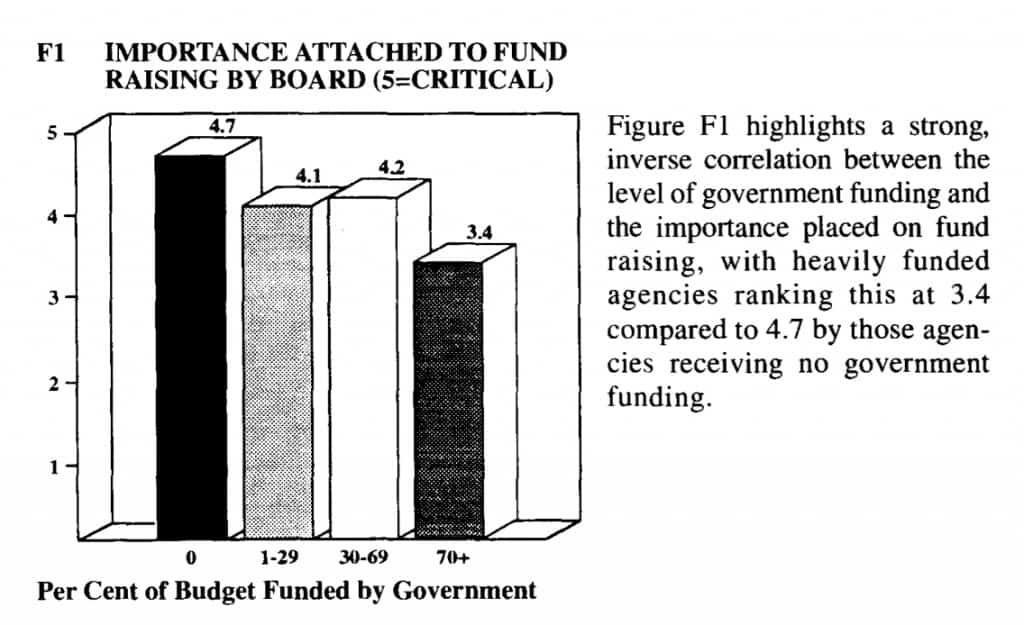
Discussion
Boards of voluntary social welfare agencies who do not, and have not, received government funding are markedly different in their approach to fund raising. They consider this function more important, and are consistently more directly involved in all aspects of agency fund raising.
To the extent that privatized agencies have not had to rely on traditional fund-raising activities, and are facing increasingly scarcer resources from their government funders, such agencies may require new approaches and criteria for structuring their boards of directors. For now, many satisfy themselves with simply appointing board members who are able to donate personal funds. Boards that are not actually restructured to include greater fund-raising orientation and expertise should, at the very least, acquire or develop such skills internally through training, expansion or external consultation.
Organizational Planning
Voluntary social welfare agencies, when compared to the overall sample of 417 NFP organizations, consider it more important that their board members share an ideology about the agency: on a scale of 1-5, where the higher average indicates greater importance, voluntary agencies’ average was 3.7 versus 3.4 for all respondents.
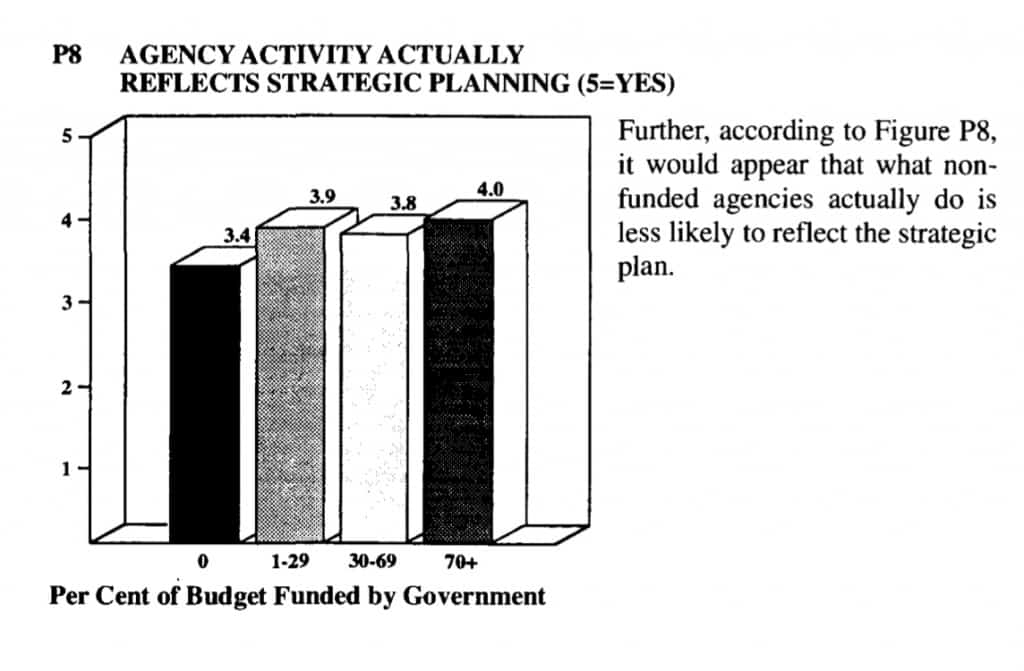
Discussion
It would appear that government funding comes with more strictures on matters such as long-term planning and advocacy, but with less concern over beliefs than funding from other sources. In other words, the government funding bodies are not concerned with what boards of voluntary social welfare agencies believe, but are concerned with what they do! In contrast, the “connections” between funding and board behaviour and board roles seems far more tenuous for organizations who receive their funds from non-government sources.
The data also suggest that non-funded agencies are more “internally focused”, while voluntary social welfare agencies funded by the government are more “externally focused”, i.e., we would suggest that the boards of non-funded agencies-either by necessity, preference or design-tend to be oriented to what goes on inside the agency as a means of ensuring organizational success, whereas boards of government-funded agencies must more often turn their attention outside to receive recognition for achieving their goals, then utilize that recognition in support of their efforts to secure future government funding. This view of the situation faced by heavily funded agencies is supported by a further perception that, since the requirement for “Good Connections” appears not to be linked to any advocacy efforts, it is probably linked to the funding relationship.
Lastly, strategic planning appears to be an area that many voluntary social welfare agencies, or at least their Executive Directors, consider leaves much room for improvement. The extent to which such planning is not undertaken at all, or apparently not taken seriously, is noteworthy when compared to the importance placed on strategic planning. (See Table 5, where this function was ranked a high third in relative importance for the board.)
Board-Management Relations
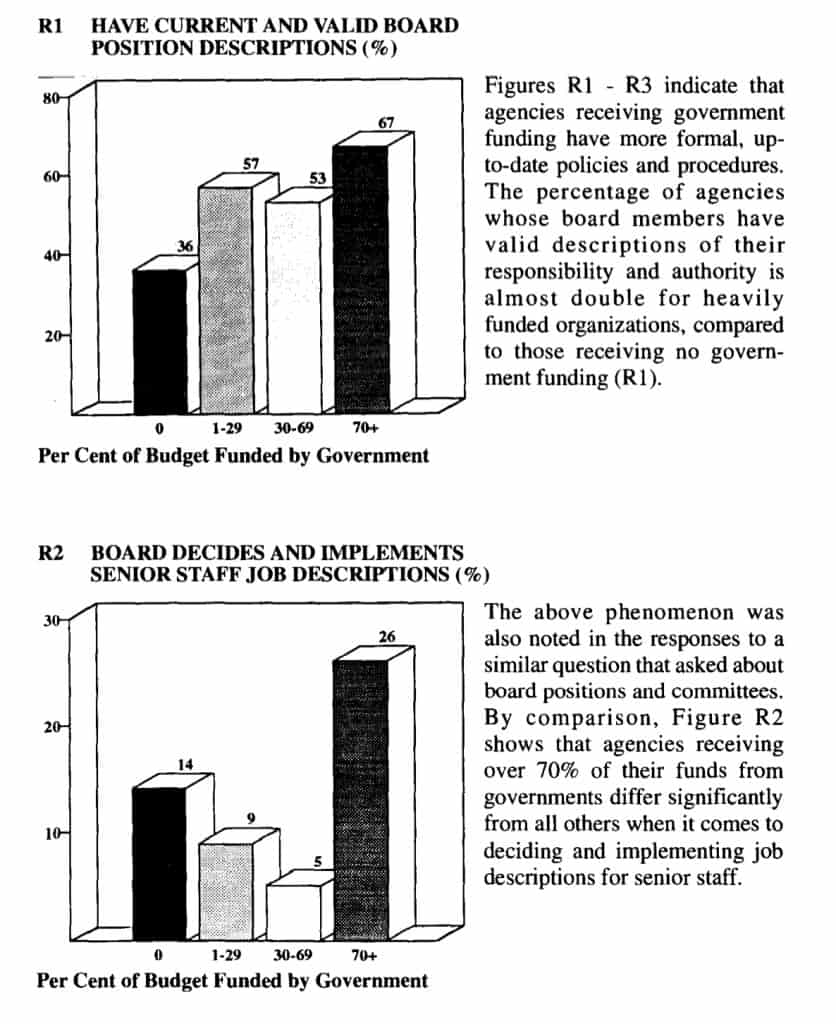
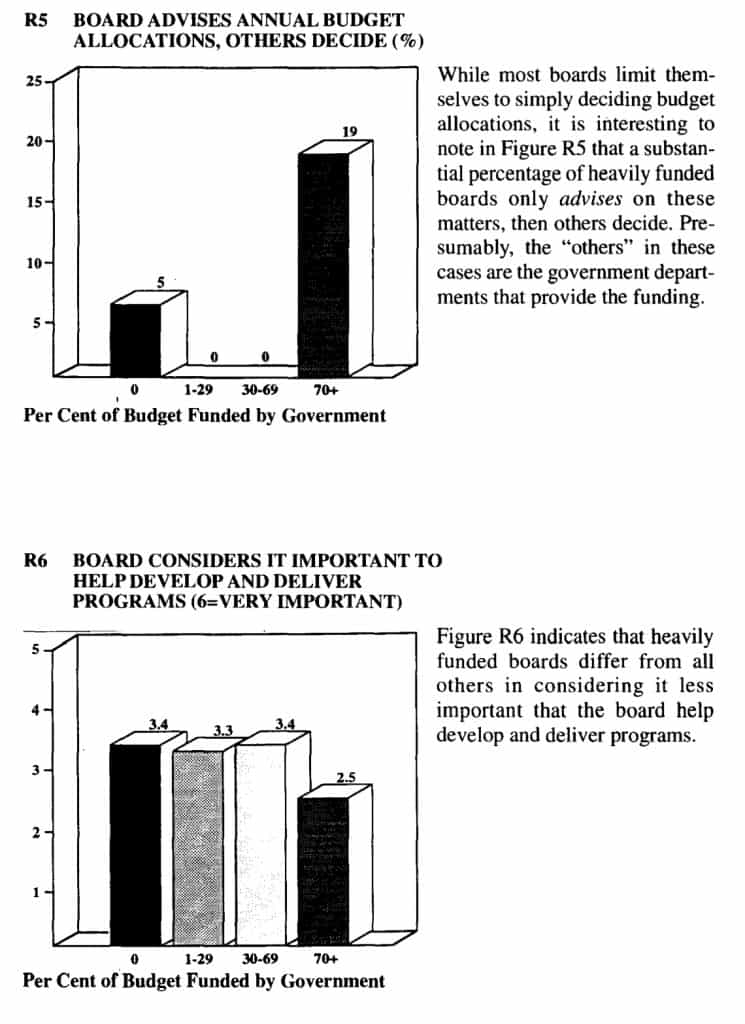
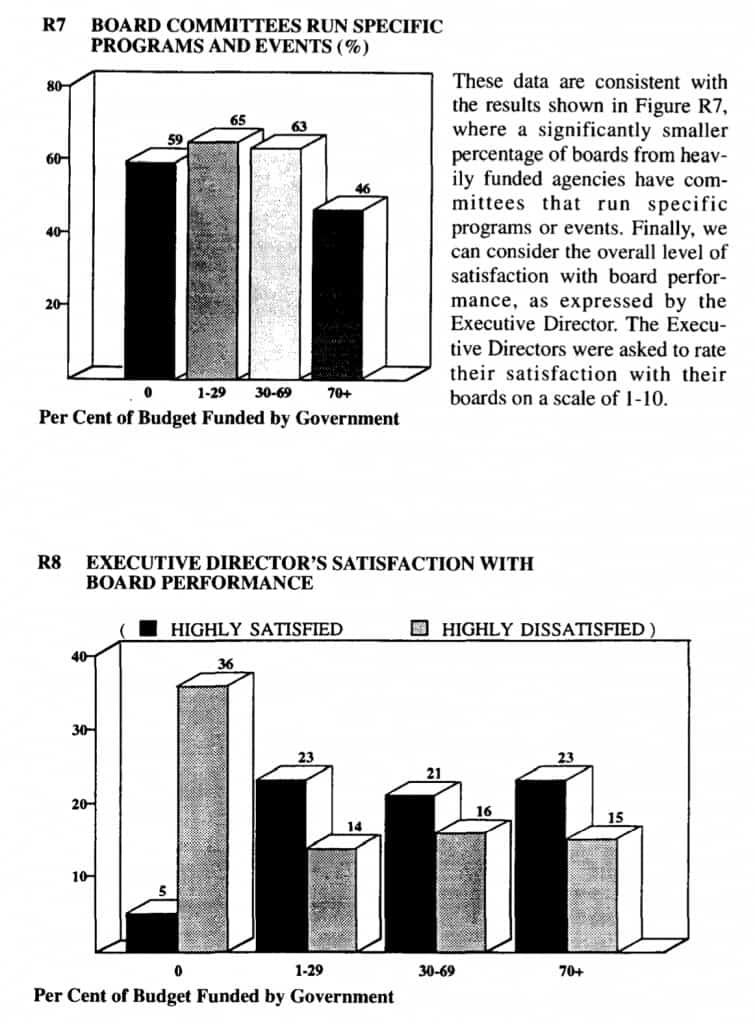
Figure R8 above provides the 1-3 and 8-10 results, clearly demonstrating that there is much less satisfaction with the boards of non-funded agencies than with those of funded agencies. It is interesting to note that the percentage of respondents which rated their boards at the two extremes is relatively close in all categories, ranging from 37% to 41%.
Discussion
A clear picture emerges of more formality but less “hands-on” involvement in operations among government-funded agencies. The boards of all governmentfunded agencies also received similarly better satisfaction ratings from their Executive Directors than did their counterparts at non-funded agencies.
While at first glance there may be a temptation to conclude that the above two results are connected, the following points suggest that such a conclusion may be overly simplistic. Note also where all government funded agencies are similarly different from non-funded agencies, compared with those instances where heavily funded agencies differ from all others-non-funded and “less-funded”:
The percentage of agencies having formal board orientation programs is close for all funded agencies-who also have more descriptions of board responsibilities and authority, but only heavily funded organizations decide and implement senior staff job descriptions.
All funded agencies are more “hands-off’ than unfunded agencies regarding budget implementation, while only heavily funded agencies have budget decisions made by others.
Only heavily funded agencies differ in board involvement in the development and delivery of programs, yet the boards of all funded agencies receive similarly better satisfaction ratings from their Executive Directors.
Lastly, when Executive Directors were asked how good a job their board did in appointing and evaluating the paid top manager (i.e., themselves!), the Executive Directors of heavily funded agencies far more frequently responded in the extremes of either “Needs Improvement” or “Couldn’t Do Better”.
Summary and Conclusions
This paper explored the impact of privatization on the role of the board of directors for voluntary social welfare agencies, by addressing such key functions as fund raising and planning, as well as board-management relationship in operations. The focus was on the third type of privatization, whereby government maintains the responsibility for funding public services, but transfers the delivery of such services to the voluntary sector.
The sample of91 voluntary social welfare agencies was divided into four groups, categorized by their level of government funding. A majority of the attention was focused on the two extreme groups-those with no government funding compared to those receiving at least 70 per cent of their funds from government sources.
It was noted that organizations receiving no government funding place greater importance on fund raising, and that their boards are more consistently involved in all aspects of agency fund-raising efforts. The data indicate that privatized agencies, particularly those that are heavily funded by government, may be placing themselves in jeopardy through their lack of emphasis on fund raising. Experience has shown that funding cuts can come quickly, and that developing an effective fund-raising capability can take years. The authors suggest that all such agencies begin developing fund-raising strategies and expertise now, especially at the board level.
The findings on long-term and strategic planning were rather puzzling. While this function is ranked very high in importance by respondents (Table 5), which is consistent with the literature on board roles and responsibilities, it was surprising to observe that the boards of fully half the heavily funded agencies and one-third of non-funded settings never undertake such activity. Further, while boards of non-funded agencies appear to do more strategic and long-term planning, the Executive Directors reported that their efforts are often “less than serious” and that what the agency does often does not reflect the plan! It is possible that the boards of fully funded agencies consider such efforts as redundant or wasted, given the direction that their government funding department provides. This conclusion was supported by a related finding which showed that government funded agencies are more likely to reflect the expectations of key external bodies, such as funders. Whatever the explanation for this anomaly, the data clearly demonstrate that long-term planning is considered sufficiently important to warrant more serious effort than is currently being expended.
Regarding board-management relations, this paper demonstrated that major differences exist between funded and non-funded organizations. It was not clear, however, that the differences were due to constraints that may be included with government funding (or be largely absent in non-funded settings), or were the result offunded agencies enjoying budgets that more often include allocations for items such as formal training programs, job reviews, etc. That such widespread differences exist suggests that further study of this issue, focusing on why the differences exist and what, if any, impact they have on organizational effectiveness, would be worthwhile.
APPENDIX A
Sector Comparison of Overall Respondents
REFERENCES
Azim, A.N. “Privatization of Social Services: Potential Implications and Consequences” in Ismael and Thomlison (eds). Perspectives on Social Services and Social Issues. Ottawa: Canadian Council on Social Development, 1987.
Beli-Lowther, Erica. “Privatization: Increasing Government Efficiency or Dismantling the Welfare State?”. The Social Worker. Vo1.56 (3), 1988.
Carver, John. Boards that Make a Difference. San Francisco: Jossey-Bass, 1991.
Hurl, Lorna. “Privatized Social Service Systems: Lessons From Ontario Children’s Services”. Canadian Public Policy. (10), 1984.
Ismael, Jacqueline S. and Yves Vaillancourt (eds). Privatization and Provincial Social Services in Canada. Edmonton: The University of Alberta Press, 1988.
James, Gayle, Glenn Drover and Richard Ramsay. “Beyond the Welfare State: Brief to the Royal Commission on the Economic Union and Development Prospects for Canada”. The Social Worker. Vol. 51 (4), 1983.
Kramer, Ralph M. Voluntary Agencies in the Welfare State. Berkeley: University of California Press, 1981.
Mishra, Ramesh, Glenda Laws and Priscilla Harding, “Ontario” in Ismael and Vaillancourt (eds). Privatization and Provincial Social Services in Canada. Edmonton: The University of Alberta Press, 1988.
O’Connell, Brian. The Board Member’s Book. New York: The Foundation Center, 1985. Robichaud, Jean-Bernard. Voluntary Action: Provincial Policies and Practices. Ottawa: Canadian Council on Social Development, 1985.
Slavin, Simon (ed). An Introduction to Human Services Management, Volume I of Social Administration, New York: The Haworth Press, 1985.
Stoez, D.A. “Wake for the Welfare State: Social Welfare and the Neo-conservative Challenge”. Social Service Review. September, 1981.
Trecker, Harleigh B. Social Work Administration: Principles and Practice. New York: The Association Press, 1971.
Wilensky, Harold L. and Charles Lebeaux. Industrial Society and Social Welfare. New York: The Free Press, 1958.
KEN BOWLBY
Department of Economics, Business and Mathematics, King’s College, The
University of Western Ontario
PETER C. McMAHON
Department of Social Work, King’s College, The University of Western Ontario
PAT BRADSHAW
Faculty of Administrative Studies, York University
VICTOR MURRAY
Faculty of Administrative Studies, York University
